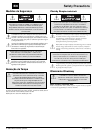
5INSTALLATION
5.1 Mounting
The LTC 8786 Series Data Converters are rated for indoor use
only. If desired, four (4) holes are provided for mounting the
unit to a flat surface. See MOUNTING DIMENSIONS at the
end of this document.
If using on a desktop, attach the supplied rubber feet to the
bottom of the unit.
A cable suitable for use with RS-232 signals (not supplied)
must be used between the RS-232 device and the LTC 8786
unit. If the distance between the RS-232 device and the LTC
8786 unit is over 20-30 meters (60-90 ft), the use of 'short
haul modems' (not supplied) or other RS-232 line extender
devices may be required. An RS-232 simplex transmission rate
of 9600 baud will need to be supported by the link.
5.2 Power Supply Connections
Install the LTC 8786 unit within 1.8m (5.75) of the mains
power source. Connect the 'bayonet' style connector of the
power supply cable into the jack located on the side of the
converter unit. Plug the power supply adapter into a
suitable AC power source.
If the power supply must be located beyond 1.8m, the
provided power supply cable can be extended, or replaced
with an appropriate user-supplied cable. The LTC 8786
is not polarity-sensitive, so it does not matter which
direction the cable is attached to the power supply adapter.
If desired, a user-provided power supply may be used
with the data converter. A power supply having either a
15-20 VDC ± 10%, 400 mA or 12-18 VAC ± 10%,
400 mA output is required.
If necessary, replacement power supply adapters can be
ordered as noted below:
120 VAC input: KBD-120PS Power supply and power cable.
230 VAC input: KBD-220PS Power supply and power cable.
5.3 Data Input Connections
Two (2) data input connections to the converter unit
are available. Only one can be used at a time, and the choice
varies depending upon the specific application. Although var-
ious connection options are possible, typical applications are
described in the sections that follow. Use whichever
application is most suitable to your configuration. Typical
configuration diagrams are included in this manual for
reference.
5.4 PC RS-232 Interface Using a 9-Pin
Connector
In this application, the LTC 8786 is connected directly to the
serial port of a PC. The user-supplied software installed on
the PC must be designed to output "Receiver/driver and
AutoDome RS-232 Control Code Protocol" data. This RS-232
data is converted into Allegiant biphase protocol using the
LTC 8786 unit. The biphase data is then connected to the
AutoDome cameras or Allegiant receiver/driver units as
described herein.
Attach an RS-232 standard null modem cable (part No.
S1385) to the serial port of the PC. Connect the other end of
the data cable to the 9-pin connector on the LTC 8786 con-
verter unit.
Skip to the section on AUTODOME CAMERA OR
RECEIVER/DRIVER SITE CONFIGURATION to complete
the installation.
5.5 RS-232 Interface Using RJ-11
Connector
Connect one end of a suitable data cable to the RJ-11 jack
on the LTC 8786 converter unit. The other end of the cable
must now be interfaced to the RS-232 communication link.
Only the RX and SIGNAL GROUND connections are
required.The remaining pinouts should remain 'un-connected'.
If the distance between the RS-232 communication link and
the LTC 8786 converter unit is greater than 3 m (10), install
an appropriate length of cable suitable for use with RS-232
signals (user-supplied). Since the data format is an RS-232
simplex transmission, only 2 signal wires (DATA and
GROUND) will be required.
If the distance between the LTC 8786 unit and the camera site
is over 20-30 m (60-90 ft), the use of short haul modems
(user-supplied) or other RS-232 line extender devices may be
required. They must be able to support an RS-232 simplex
transmission rate of 9600 baud.
The wiring pinouts of the LTC 8786 series is shown in the
PINOUTS section.
5.6 Remote RS-232 Device Interface
In this application, Allegiant biphase control code is being
converted into RS-232 which is then transmitted over an
RS-232 communication link (fiber optics, microwave, dial-up
phone modems, etc.). At the camera side end of the RS-232
transmission link, the RS-232 data is converted back into
Allegiant biphase protocol via the LTC 8786 unit. The
biphase data is then connected to AutoDome cameras or
Allegiant receiver/driver units.
The RS-232 communication link must be able to support an
RS-232 simplex transmission rate of 9600 baud.
Installation
EN
© 2003 Bosch Security Systems Page 8 of 12














